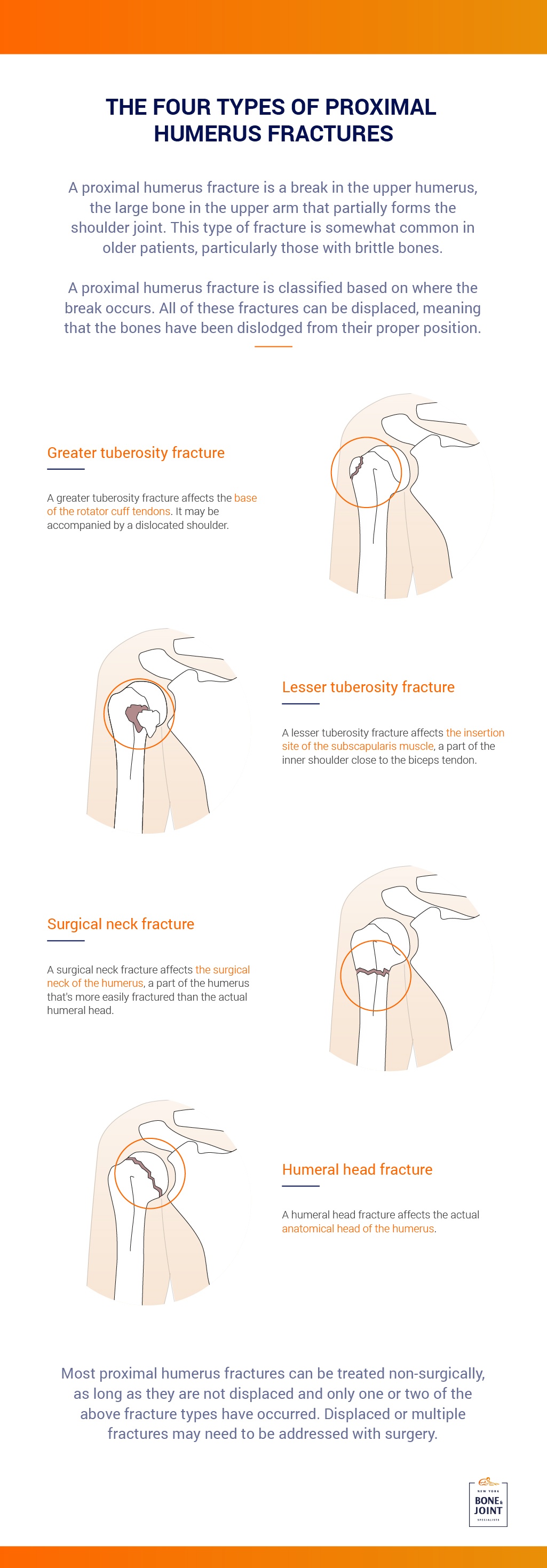WHAT IS A PROXIMAL HUMERUS FRACTURE?
A proximal humerus fracture is a break in the upper end of the humerus, the bone in the upper arm which partially forms the ball of the shoulder joint. Though less common than other shoulder fractures, it often occurs in the elderly and patients with osteoporosis, since brittle bones are more prone to fracture in the event of trauma.
PROXIMAL HUMERUS FRACTURE SYMPTOMS
Symptoms of a proximal humerus fracture can differ from patient to patient, but like most fractures, the most common symptom is sudden pain and swelling in the shoulder and upper arm. Other common symptoms include:
- Significant bruising
- A greatly restricted range of motion
- A sense of numbness in the affected arm
- A visible deformation of the shoulder or upper arm
TYPES OF PROXIMAL HUMERUS FRACTURES
Proximal humerus fractures are classified according to the site of the injury. If a fracture is “displaced,” as any of the following fracture types can be, this means that the bones have jutted outward from their proper position.
Greater Tuberosity Fractures
A greater tuberosity fracture affects the greater tuberosity of the humerus, which is the insertion site (or base) of the rotator cuff tendons. Such fractures are often accompanied by a dislocated shoulder.
Lesser Tuberosity Fractures
A lesser tuberosity fracture affects the lesser tuberosity of the humerus, which is the insertion site of the subscapularis muscle. These fractures can significantly weaken the muscle, preventing the entire shoulder from functioning properly.
Surgical Neck Fracture
A surgical neck of the humerus fracture affects the surgical of the humerus — a segment of the bone that’s much more easily fractured than its actual anatomical neck. It can result in damage to the axillary nerve.
Humeral Head Fracture
A humeral head fracture affects the head of the humerus, which makes up the ball of the shoulder joint. Though rare in younger patients, it’s quite common in the elderly.
PROXIMAL HUMERUS FRACTURE TREATMENT AND RECOVERY
Treatment
Treatments for proximal humerus fractures vary with the location and severity of the injury, with some cases responding well to conservative treatments and others requiring surgical intervention. Conservative treatments are generally centered around rest and a physical therapy program designed to rebuild the surrounding muscles and restore a complete range of motion to the affected shoulder, while surgical treatments are designed to reset and stabilize the bone with metal screws or plates. If the bone has become dislodged from the socket or caused damage to surrounding tissues or structures, surgery is generally the best option.
Recovery Time
Recovery timelines for patients with proximal humerus fractures can vary significantly, particularly if the injury has been surgically treated. Should you opt for more conservative measures, you’ll need to keep your arm in a sling for two to three weeks after sustaining the injury. You can start performing some light stretching exercises within a week, however, and begin physical therapy as soon as you’ve removed the sling. While the bone may take as long as six to twelve months to completely heal, you should be able to resume most daily activities after four to eight weeks.
A surgically treated proximal humerus fracture requires a longer recovery period than a conservatively treated fracture. After the procedure, you’ll need to keep your arm in a sling for several weeks and take anti-inflammatory medication as needed. Physical therapy can begin three to four weeks after surgery, and you should be able to resume most daily activities after eight to twelve weeks of rehabilitation. Similar to the timeline for conservative treatment, complete recovery can be expected in six to twelve months.











